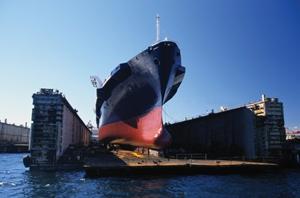The importance of vessels being fit for the voyage

A Tribunal recently had to consider the question of whether a vessel was or was not fit to moor and stay alongside an unusual loading installation in the Mediterranean - London Arbitration 11/14.
Due to the nature of the installation, specific and well-established mooring practices were in operation for vessels using the facility. The cargo would be loaded along a belt conveyor on a finger jetty which extended out some 546 metres. A spout was located at the end of the jetty which would then deliver the cargo into the vessel’s holds. The jetty itself was unfendered so the vessel could not berth alongside in the traditional sense. The berthing manoeuvre involved the vessel approaching the jetty at an angle; she would then drop her port anchor and start a swing to port with the bow moving to port and the stern to starboard. She would be secured at a distance of about 2-3 metres off the jetty secured to eight surrounding buoys. Lines would be thrown to connect to the buoys during the berthing manoeuvre and it was a minimum requirement of the facility that eight polypropylene ropes of 200m in length or longer were needed to facilitate safe berthing. The use of wire ropes was prohibited.
Under clause 2 of the charter the vessel had to be “in every way fitted for the voyage" There was no safe port/berth warranty contained in the charter party, perhaps as the installation could not be considered as a true port/berth. As such it was for the Owners to satisfy themselves that the vessel was indeed fully fitted for the voyage from the Mediterranean to the United Kingdom and this would include whether she was fitted to use the loading facility in a safe manner.
The vessel, which was fixed on a voyage charter, was due to arrive at the installation on 10 November. Four days prior to that date the agents informed the Owners that eight polypropylene ropes would be required to use the installation. On 9 November the master advised that the vessel did not have the required number of ropes as only one of the ropes was 200m long with the rest being slightly shorter. The master also advised that four wire ropes were available. Discussions between the agents and the master led to the vessel acquiring two further 220m polypropylene ropes at an intermediate port. Despite the additional ropes the vessel still only had four ropes between 200m-220m. During these exchanges the agents continued to stress the minimum requirement was for eight polypropylene ropes.
Notice of Readiness was tendered on 12 November. The following day, the shippers’ port captain boarded the vessel to present a mooring scheme and to inspect the mooring equipment available to the vessel. He reported back to the shippers that the vessel should be rejected as it did not conform to the basic safety requirements to call at the installation. Although the message did not mention the number or length of the ropes, in the tribunal’s opinion it was the vessel’s mooring ropes and wires that was in port captain’s mind.
Shippers were concerned and as a result charterers received an email on 16 November requesting that the vessel be withdrawn from the installation. Charterers relayed a message to Owners that as the vessel could not be accommodated at the installation and that Owners would need to nominate a suitable substitute vessel failing which charterers would seek an alternative vessel.
Owners purported to accept the conduct of charterers as repudiating the charter and claimed damages for US$ 103,647 for charterers repudiatory breach in rejecting the vessel. Charterers counterclaimed for the cost difference of the substitute fixture they entered into.
Experts instructed by the parties found no fault with the mooring practices engaged at the installation. They did though differ over the alternative schemes proposed by the master when it looked like the vessel would be rejected by the facility albeit the tribunal was persuaded by the charterers expert that the master’s proposal - to use a composite line - would be risky.
Upon the facts presented the tribunal held that the Owners claim failed as it was they who were in repudiatory breach of the charter party. The vessel was not fitted for the voyage as there would have been “serious and unacceptable” risks involved in mooring the vessel and/or in shifting her to render such operations unsafe. Charterers counterclaim succeeded and they were awarded £35,000 together with interest representing the losses incurred in fixing the substitute vessel.
Though this matter was in relation to a voyage charter where the discharge port was known the same applies to time charters. In London Arbitration 19/01 it was held that Owners would be responsible for the costs of hiring additional mooring ropes necessary to call at a port in Northern Chile as it should have been in their reasonable contemplation when entering into the charter party of the possibility of mooring requirements such as those required at that Port. Both cases demonstrate the importance of Owners exercising due diligence to ensure the vessel is capable of complying with charterers instructions.


